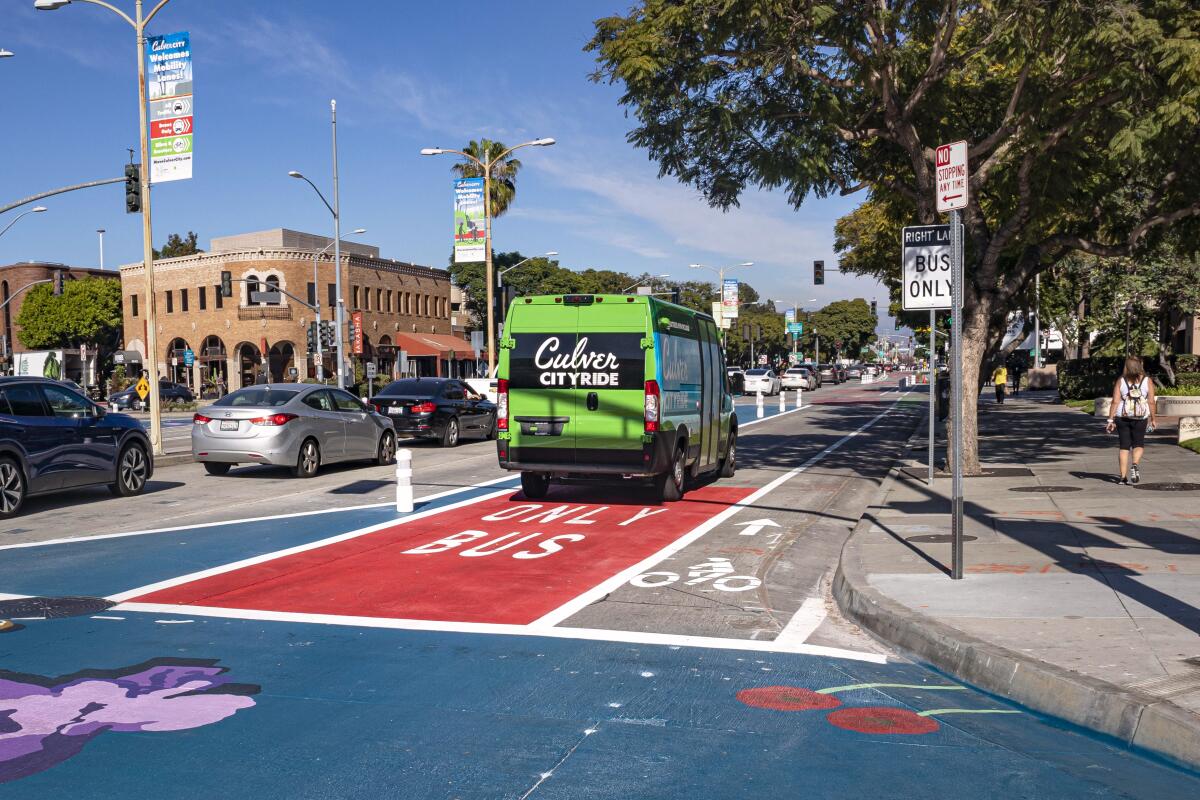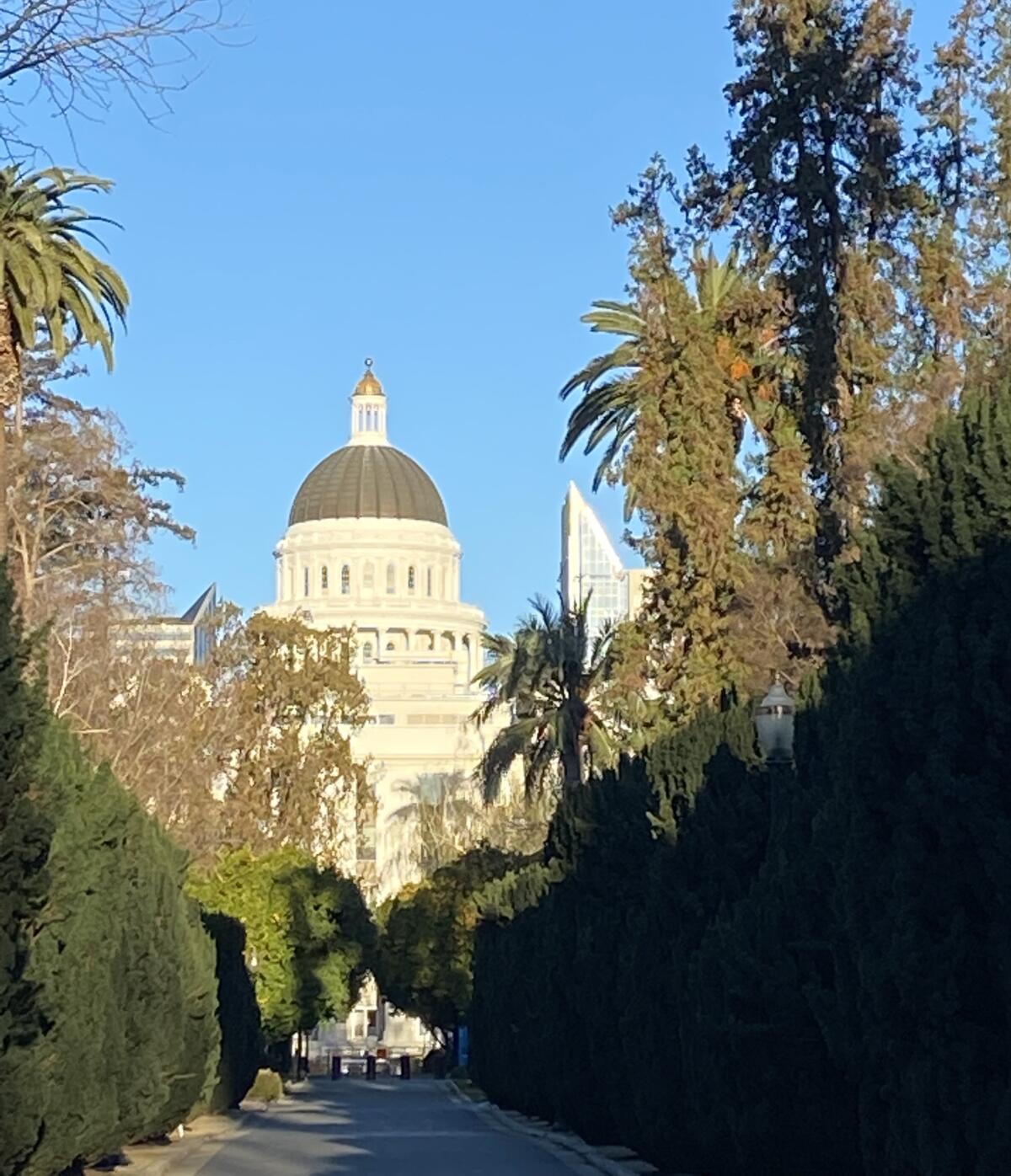In Culver City’s street space battle, cars are set to make a comeback

- Share via
Good morning, and welcome to the Essential California newsletter. It’s Wednesday, April 26.
Traffic congestion is a soul-crushing nightmare, but take a good look in your rear-view mirror and you just might see the cause of your suffering: drivers, mostly sitting alone in their cars. And in the foreground? Well, that’s you, most likely alone, also driving your car.
The solution to gridlock is fairly simple in concept: Make cities more walkable, bikeable and transit-rich. Make it easier for people to get around without using cars, and they’ll drive less.
But if you’ve tried walking, biking or taking transit in L.A. County, you know that’s easier said than done. An ambitious project in Culver City aimed to be the exception, but the people-oriented plan lost ground this week.
A multimodal experiment
The project, called Move Culver City, created dedicated bike lanes in each direction of a 1.3 mile downtown corridor, buffered by bus-only lanes. The street overhaul, which launched in November 2021, took away space for cars by reducing car lanes to one in each direction.
Transportation officials in the city of about 40,000 laid out their vision for the project: “a reimagining of our streets as public spaces [that] prioritizes moving people over cars.”
And in terms of those goals, the project made some promising gains. The city’s Transportation Department released a report this month to show travel impacts on the corridor. It showed:
- Cycling activity increased 57% compared with pre-pandemic levels
- Bus ridership was up by 38%
- Micromobility trips — mostly on electric scooters — shot up 68%
As far as car traffic, transportation officials monitored traffic volume at several intersections along the project corridor. That showed travel times changed very little compared with pre-implementation — weekday peak travel took about two minutes longer for drivers going westbound, while peak travel was on par with 2019 times for eastbound drivers.
A win for cars
Despite the early data, the City Council voted 3 to 2 Monday night to remove the dedicated bike lanes — opting to have cyclists share a lane with buses — and restore car lanes to the corridor “where feasible.” City leaders promised to reassess in two years.
“I hope the data says the buses are better, it’s a better option for our residents and that the two lanes of (car) traffic are worse and we need to go back to one [and] bring back dedicated bike lanes,” Councilmember Dan O’Brien said before voting to remove bike lanes.
Many residents and frequent visitors to the city defended the project and its bike lanes during hours of public comment, saying it increased safety and contributed to climate goals. Others argued that adding back car lanes would make it easier to drive through the area and visit local businesses.
Culver City Mayor Albert Vera, who voted in favor of the change, called restoring car lanes “a compromise.”
Vice Mayor Yasmine-Imani McMorrin disagreed. She argued that the dedicated bus and bike lanes are already a compromise. “Most of our infrastructure here centers cars,” she said in the meeting.
Fewer cars mean less congestion, less harmful air pollution and quieter, calmer streets. Creating dedicated space for people to bike and improving pedestrian infrastructure means fewer people interact with car drivers, which means fewer collisions.
Drivers want less traffic but still want to drive
So why, with data showing more people were taking transit, biking and walking in the area, did city leaders vote to scale back the project?
I reached out to each of them and did not hear back by deadline. But during this week’s lengthy council meeting, each pointed to a March survey of Culver City residents in which a majority opposed the mobility project.
And here’s where it gets confusing: The majority of surveyed residents support the safety improvements the project brought to pedestrians and cyclists, and better transit through the corridor. But those same residents strongly oppose the reductions to car lanes that made those improvements possible.
That’s the dichotomy that exists across L.A. County and the rest of car-centric California. On one side: a desire to make our streets safer and more enjoyable. On the other? An unwillingness to actually address the elephant on the road: our loud, dangerous, pollutant-spewing machines.
That desire to have it both ways remains “a common theme in American city planning,” said Michael Manville, an associate professor of urban planning at the UCLA Luskin School of Public Affairs.
“Because we don’t want to address congestion at its root, we often end up in strange zero-sum battles, that we hope will stop it from getting worse,” he said.
That root cause is clear, according to Manville:
“Driving is underpriced and too many of us try to do it all at once, and that’s the main way we all slow each other down.”
The Culver City project represented a first for L.A. County, he said, explaining that the political will demonstrated by city leaders was notable in a region that talks a big multimodal game but has little to show for it.
“If the region was going to actually embrace its rhetoric, this was going to be an interesting test case,” Manville told me. “The fact that it’s being scaled back is a sign that this is still a very uphill battle for these kinds of improvements.”
It’s not yet clear how much space on the corridor will be ceded for car travel. But for residents who complained about traffic on the corridor, there’s ample evidence that congestion will get only worse as space for cars returns. Just like adding dedicated space to ride bikes led to increased bike trips, adding more space for cars will lead more people to drive on those streets (a long-recognized concept known as induced demand).
Plenty of plans, lack of will
The city of L.A. has similar plans to connect its fragmented bike lanes into a usable network and shore up amenities for pedestrians and transit riders citywide by 2035. But seven years into that 20-year plan, city leaders acknowledged that only about 3% of the street miles identified for improvements had been upgraded.
That lack of progress drove a coalition of safety advocates to mobilize, gathering enough petition signatures to add a local measure to next year’s ballot that would legally compel the city to follow its plan.
Meanwhile, city, county and state goals to improve street safety, reduce harmful emissions and curb congestion by promoting more diverse mobility options remain largely immobile.
“The status quo we have is one where the roads are big and unpleasant,” Manville said. “On the level of rhetoric, everyone agrees that we want to move toward this more human-scaled, multimodal Los Angeles region, where people have an abundance of choice in the way they move around and ... modes that are better for the environment.
“But yet, when push comes to shove, we can’t really seem to muster the willingness to actually do it,” he said.
And now, here’s what’s happening across California:
Note: Some of the sites we link to may limit the number of stories you can access without subscribing.
L.A. STORIES
The city of L.A. tried to force a journalist and a police watchdog group to return more than 9,000 photos and names of LAPD officers that it had released to the group. But a county judge rejected the city’s request for a temporary restraining order against the reporter and watchdog group Tuesday. Los Angeles Times
POLITICS AND GOVERNMENT
Gov. Gavin Newsom visited the long-dry, now flooded Tulare Lake on Tuesday, vowing to assist San Joaquin Valley communities affected by floodwaters amid the risk of more flooding as California’s snowpack melts and flows toward them. Newsom wasn’t flush on details though. “We’re assessing the rules of engagement. They’re not well established,” he told reporters. San Francisco Chronicle
California’s lowest-paid health workers, which includes nursing assistants, patient aides, medical technicians and janitorial workers, are seeking a pay boost. But many industry leaders are pushing back, arguing some smaller facilities are understaffed and already struggling financially. CalMatters
Early in the COVID-19 pandemic, Gov. Newsom announced 1,300 trailers had been procured to house people experiencing homelessness. So what happened to them? Some city and county governments put them to use, while others still sit in storage. KQED
CRIME, COURTS AND POLICING
Anthony Avalos’ mother and her boyfriend were sentenced to life in prison for the 2018 murder of the 10-year-old boy. Heather Barron and her boyfriend, Kareem Leiva, were convicted last month of killing Anthony after years of torturing him and his siblings. Los Angeles Times
The Fresno County Superior Court will reportedly end a late-fee program for traffic tickets following a lawsuit brought civil rights organizations. Attorneys said the program preyed on low-income people of color to generate revenue for the court systems. The Fresno Bee
Support our journalism
HEALTH AND THE ENVIRONMENT
Zero-emission vehicle sales in California have surpassed 1.5 million. A surge in sales in 2021 and 2022 helped the state reach a 2025 goal nearly two years early. Los Angeles Times
Gray whales typically spend a day or two in the San Francisco Bay on their migration between Mexico and Alaska. But lately, more whales are staying longer, with one cetacean lingering for 75 days and counting. That has scientists worried the animals could be struck by ships as maritime traffic swells in the bay. Los Angeles Times
Free online games
Get our free daily crossword puzzle, sudoku, word search and arcade games in our new game center at latimes.com/games.
AND FINALLY
Today’s California landmark is from Rebecca Carey of Santa Maria: the tree-rich grounds of the California state Capitol in Sacramento.

Rebecca writes:
It has the most beautiful array of mature trees I’ve ever encountered. Whenever I’m in Sacramento for a conference, I plan on spending my downtime walking amongst the gorgeous trees.
What are California’s essential landmarks? Fill out this form to send us your photos of a special spot in California — natural or human-made. Tell us why it’s interesting and what makes it a symbol of life in the Golden State. Please be sure to include only photos taken directly by you. Your submission could be featured in a future edition of the newsletter.
Please let us know what we can do to make this newsletter more useful to you. Send comments to [email protected].
Sign up for Essential California
The most important California stories and recommendations in your inbox every morning.
You may occasionally receive promotional content from the Los Angeles Times.




